« The Stations of the Cross: Reflections for Lent and Holy Week | Home | The Second Station: Jesus, Betrayed by Judas, is Arrested »
The First Station: Jesus on the Mount of Olives
By Mark D. Roberts | Sunday, March 29, 2009
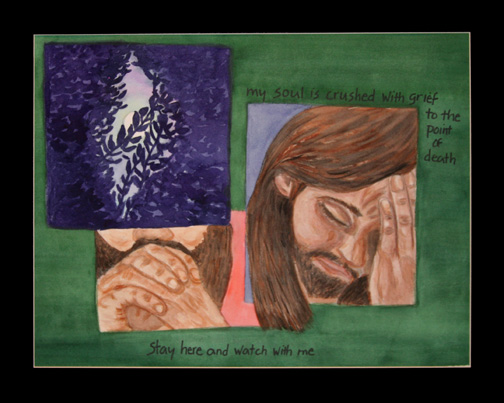
Copyright © Linda Roberts, 2007.
For permission to use this picture and/or others in this series, please contact Mark D. Roberts
Luke 22:39-46
39 He came out and went, as was his custom, to the Mount of Olives; and the disciples followed him. 40 When he reached the place, he said to them, “Pray that you may not come into the time of trial.” 41 Then he withdrew from them about a stone’s throw, knelt down, and prayed, 42 “Father, if you are willing, remove this cup from me; yet, not my will but yours be done.” 43 [Then an angel from heaven appeared to him and gave him strength. 44 In his anguish he prayed more earnestly, and his sweat became like great drops of blood falling down on the ground.] 45 When he got up from prayer, he came to the disciples and found them sleeping because of grief, 46 and he said to them, “Why are you sleeping? Get up and pray that you may not come into the time of trial.”
Reflection
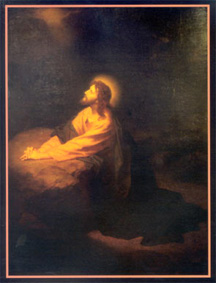 Growing up as a Christian, I always found the scene of Jesus in the Garden of Gethsemane to be a comforting one (Note 1). My feelings were shaped less by the actual story in the Gospels and more by a popular representation of the scene, first painted by Heinrich Hofmann and often reproduced by other artists and in other genres. While at summer camp, I once purchased a small wooden plaque with a reproduction of Hofmann’s original. I was reassured by the serenity and strength of Jesus in the Garden, whose halo reflected the light of God shining down upon Him. My plaque sat alongside my bed for many of my young years, encouraging me to pray and to trust God more. (Photo: “Christ in Gethsemane” by Heinrich Hofmann. Now in the Riverside Church in New York City.)
Growing up as a Christian, I always found the scene of Jesus in the Garden of Gethsemane to be a comforting one (Note 1). My feelings were shaped less by the actual story in the Gospels and more by a popular representation of the scene, first painted by Heinrich Hofmann and often reproduced by other artists and in other genres. While at summer camp, I once purchased a small wooden plaque with a reproduction of Hofmann’s original. I was reassured by the serenity and strength of Jesus in the Garden, whose halo reflected the light of God shining down upon Him. My plaque sat alongside my bed for many of my young years, encouraging me to pray and to trust God more. (Photo: “Christ in Gethsemane” by Heinrich Hofmann. Now in the Riverside Church in New York City.)
I still love that classic image by Hoffman, perhaps because it reminds me of my early devotion to Jesus. But, as I have studied the Gospel texts that describe Jesus in the Garden, I’ve come to believe that Hofmann’s image doesn’t capture the full reality of the scene. Yes, in the end, Jesus accepted the Father’s will and faithfully chose the way of suffering. But his time of prayer was anything but serene.
Matthew, Mark, and Luke emphasize the agony of Jesus in the Garden. The Gospel of Luke specifically mentions Jesus’s “anguish” or “agony” (using the Greek word agonia, which can also mean “struggle”). Moreover, Luke adds that Jesus was so intense in prayer that his sweat became like drops of blood (Note 2). In the other Gospels, Jesus explains that he is “deeply grieved, even to death” (Mark 14:34; Matt 26:38). Those Gospels also show Jesus as praying more than once before he was ready to accept the Father’s will. He was indeed struggling in the Garden.
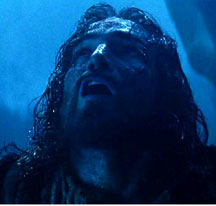 As I reflect upon the Gospel texts and their representation in art, I wonder if a more accurate image of Jesus in the Garden is found in Mel Gibson’s film The Passion of the Christ. In the movie’s opening scene, Jesus is clearly agonizing, wrestling with what lies before him. His pain is obvious, as is his struggle with his divinely-appointed destiny. (Photo: Jim Caviezel as Jesus in the Garden of Gethsemane. From The Passion of the Christ.)
As I reflect upon the Gospel texts and their representation in art, I wonder if a more accurate image of Jesus in the Garden is found in Mel Gibson’s film The Passion of the Christ. In the movie’s opening scene, Jesus is clearly agonizing, wrestling with what lies before him. His pain is obvious, as is his struggle with his divinely-appointed destiny. (Photo: Jim Caviezel as Jesus in the Garden of Gethsemane. From The Passion of the Christ.)
A struggling Jesus? A Jesus who at first wants something other than the Father’s will? A Jesus who wishes to pass on the cup of suffering? If you’re a Christian who believes that Jesus was not just a human being, but also the unique Son of God, the Word of God in flesh, then the scene in Gethsemane is truly shocking. It stretches our understanding and boggles our simplistic explanations of who Jesus really is. In Gethsemane, perhaps more than in any other scene of the Gospels, we see the fully human Jesus, the One who “though he was in the form of God, did not regard equality with God as something to be exploited, but emptied himself, taking the form of a slave, being born in human likeness” (Philippians 2:6-7). In Gethsemane we see the Savior who “in every respect has been tested as we are, yet without sin” (Hebrews 4:15).
This means, among other things, that Jesus understands what it’s like when we are tested, when we are weak, when we aren’t sure we want God’s will for our lives. In Jesus we have, not a god who is watching us from a distance as the pop song once proclaimed, but rather One who knows our every weakness, and who is there to help us in our time of trial. Indeed, Scripture teaches that Christ himself intercedes for us (Romans 8:34).
Whatever picture of Gethsemane you keep in your mind, may you let the text of Scripture fill out its meaning. May you be encouraged to come before God with complete honesty, holding nothing back. May you pour out your heart to the Lord, even as Jesus himself once did. May you wrestle with God’s will for you genuinely, so that you might accept it genuinely. As you grapple with your Heavenly Father, know that Jesus understands and is there to help you.
Prayer
Lord Jesus, as I reflect upon Your experience in Gethsemane, I am once again astounded by your utter humanness. You are not God-in-flesh-well-sort-of, but truly God in human flesh. You are Emmanuel, God with us. Thus, you are also God with me. You understand me. You stand with me in hard times. You encourage me as I wrestle with the Father’s will. And you intercede for me. How I thank You, dear Lord, for who you are, for what you have done, and for what you are doing in my life today.
Amen.
Notes:
Note 1: This garden was at the foot of the Mt. of Olives just outside of ancient Jerusalem. For some recent pictures of the area, see this page from BiblePlaces.com.
Note 2: Verses 43-44 are in brackets in the NRSV to indicate that they don’t appear in all ancient manuscripts. Some scholars believe that the verses were excised by certain scribes because of their shocking portrayal of Jesus. The majority of scholars hold that these verses were added later, and came from some tradition about Jesus that was not in the first edition of Luke.
Topics: Stations of the Cross |
One Response to “The First Station: Jesus on the Mount of Olives”
Comments
Thanks for your willingness to make a comment. Note: I do not moderate comments before they are posted, though they are automatically screened for profanities, spam, etc., and sometimes the screening program holds comments for moderation even though they're not offensive. I encourage open dialogue and serious disagreement, and am always willing to learn from my mistakes. I will not delete comments unless they are extraordinarily rude or irrelevant to the topic at hand. You do need to login in order to make a comment, because this cuts down on spam. You are free to use a nickname if you wish. Finally, I will eventually read all comments, but I don't have the time to respond to them on a consistent basis because I've got a few other demands on my time, like my "day job," my family, sleep, etc.
You must be logged in to post a comment.








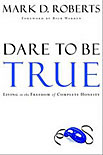



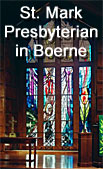


October 15th, 2009 at 5:59 am
this is a very good webistie keep iup the agodkdkk workdkjn hasnaksn topuopu and tjab e madl;f anivr fasy. so sry about the langueade im trying to sepalkn ebglish.i obdjedkgl cantr sdjtu in ebglish.so sry hiho